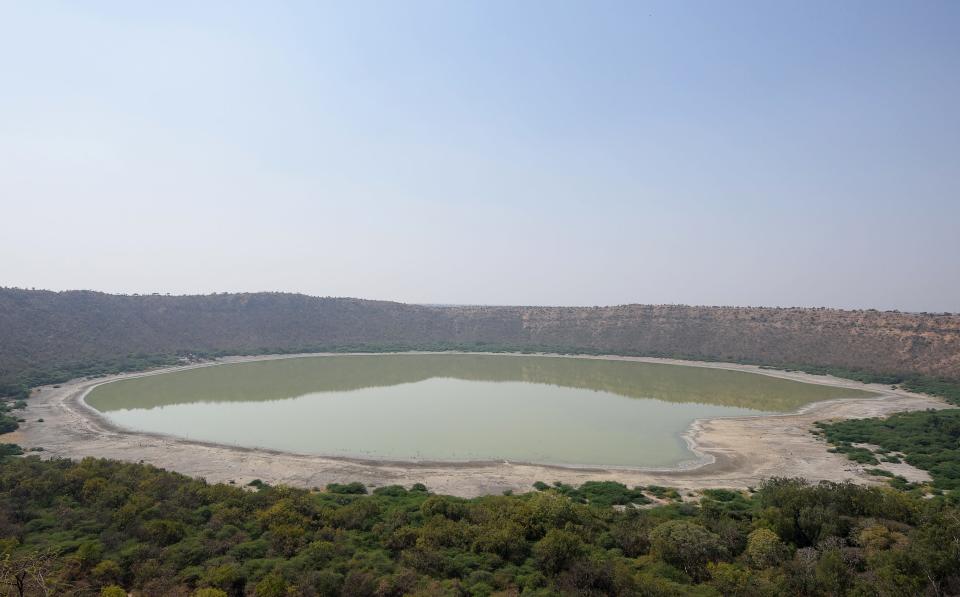Dinosaur extinction: New study suggests they were killed off by more than an asteroid
It's been 66 million years since dinosaurs roamed the Earth, and many may blame an asteroid's explosive collision with our planet for the end of the creatures' reign.
But for years, scientists have debated whether the meteorite alone is responsible for one of the most infamous mass extinction events in history, or whether other more earthly forces played a part as well.
Reigniting the debate, a recent study posited that volcanic eruptions may have already thrown the ecosystem into chaos and threatened the existence of non-bird dinosaurs before the asteroid crashing into Earth delivered the final blow.
The international team of researchers are the latest experts who claim that the world the dinosaurs roamed was one teeming with critical levels of sulfur that set the stage for their extinction. Such instability would have triggered a global drop in temperatures around the world, creating conditions inhospitable to life, according to the research.
The team's findings were published in October in Science Advances and revealed last week in a press release.
“Our research demonstrates that climatic conditions were almost certainly unstable, with repeated volcanic winters that could have lasted decades, prior to the extinction of the dinosaurs," study co-author Don Baker, a geologist at McGill University, said in a statement. "Our work helps explain this significant extinction event that led to the rise of mammals and the evolution of our species."

Study: Asteroid known as Polyhymnia may contain 'superheavy' elements unknown to humans
Did more than an asteroid wipe out dinosaurs?
The study is the latest in a longstanding scientific debate regarding what factors are to blame for wiping out 75% of life on Earth, including the dinosaurs, and ushering the end of the Cretaceous period:
Was the asteroid that slammed into present-day Mexico alone responsible for the mass extinction when it unleashed devastating tsunamis and ash that blotted out the sun? Or did massive volcanic eruptions at a site called the Deccan Traps in India doom life on Earth long before?
That question is what drew the researchers to that vast, rugged plateau in Western India formed by molten lava, where they hammered rocks and collected samples to analyze.
Analysis allowed the team to estimate the amount of sulfur and fluorine that volcanic eruptions spewed into the atmosphere 200,000 years before the dinosaurs' demise. They found that enough sulfur was released to trigger a steep enough drop in global temperatures to trigger a "volcanic winter."

Studying the volcanic history of ancient rocks
To uncover clues in the ancient rocks about the demise of the dinosaurs, the researchers developed a new technique to learn their volcanic history.
Researchers were able to measure how much sulfure was in the rock formations at the time and how much was pumped into an atmosphere in a chemical process that Baker compared to cooking pasta.
"You boil the water, add salt, and then the pasta," Baker said. "Some of the salt from the water goes into the pasta, but not much of it."
It's similar to how some elements become trapped in cooling minerals after a volcanic eruption. The team was able to calculate the sulfur and fluorine in the rock samples, just as salt concentrations in boiling water could be measured by analyzing the cooked pasta.
The data suggest that the sulfur could have been released in bursts of volcanic activity, which caused repeated short-lived global drops in temperature, according to the study. The effect would have been catastrophic climate change, marking the transition from the Cretaceous to the Paleogene period.
'Unraveling new worlds:' European astronomers find clouds made of sand on distant exoplanet

Eric Lagatta covers breaking and trending news for USA TODAY. Reach him at [email protected]
This article originally appeared on USA TODAY: Dinosaur extinction study finds more than an asteroid led to demise
